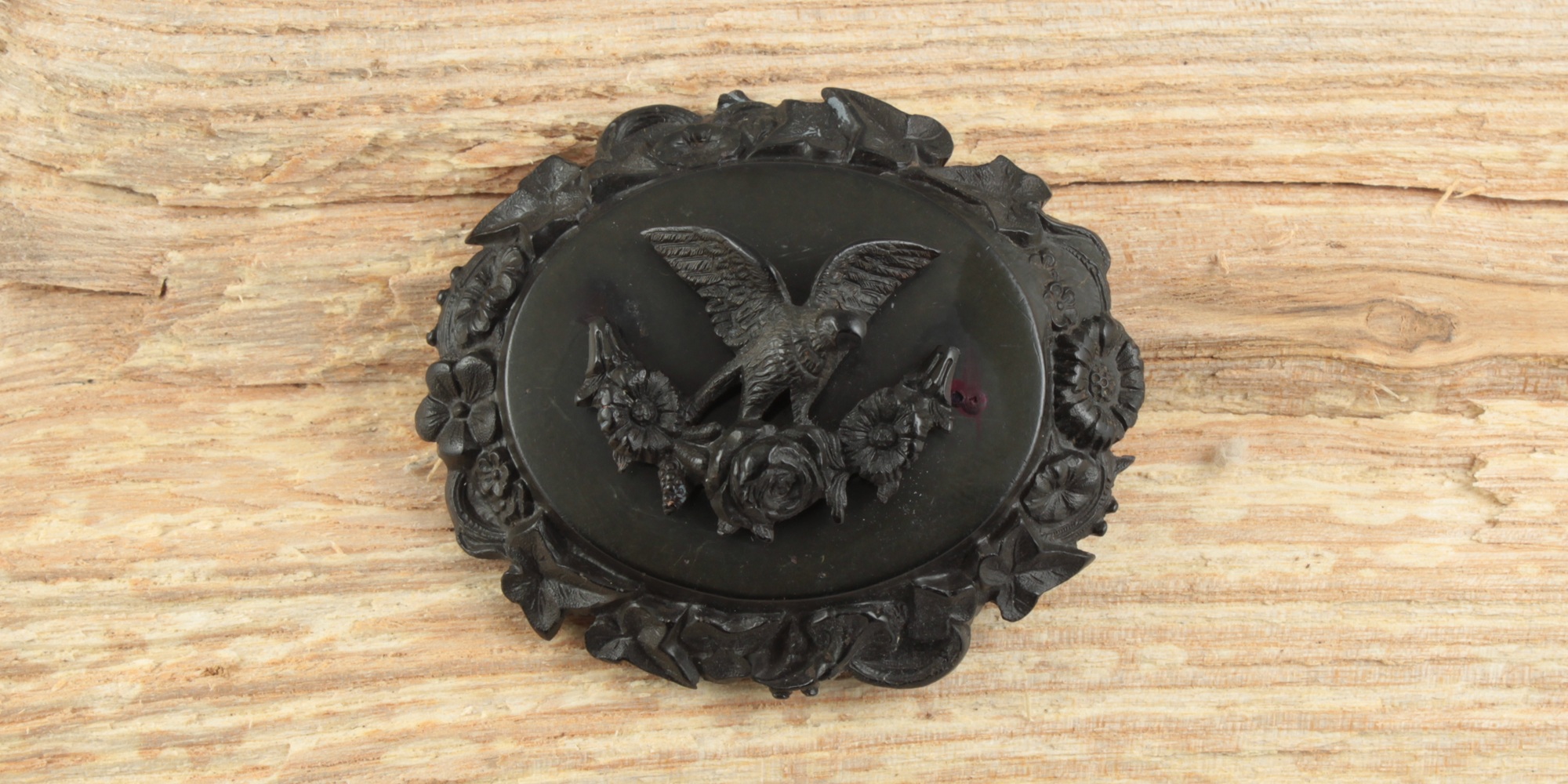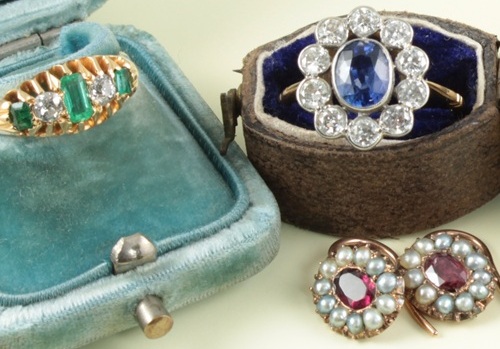Jet
Jet derives its name from the ancient town of Gagae, in the Antalya province of Turkey. The gemstone was found near the estuary of the river Gages. The ancient Greeks and Romans called the stone “Lithos Gagates” which means “Stone of Gages”. This then became the old French word “Jaiet” which in turn became Jet in English. Jet belongs to the organic group of gemstones, other well-known gemstones in this group include Coral and Pearl. Its colours can range from deep black to dark-brown. When polished, it can produce a velvety mirror-like lustre. The most valuable and sought after colour is a uniformed intense deep black, referred to in the trade as “Jet-Black”.
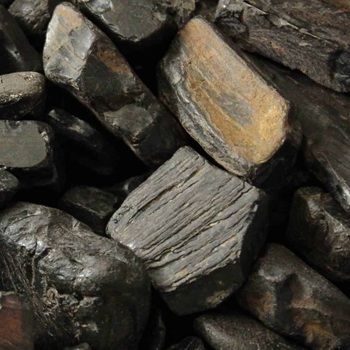 Formation: Jet is composed of a hardened form of lignite, which is the lowest rank of coal commonly called brown coal. Its formation process began millions of years ago during the Jurassic period. Ancient trees fell into swappy areas, either freshwater or saltwater areas. These trees sank into the soft mud and were covered by sediment. Which blocked out oxygen and prevented the trees from decomposing, resulting in the tree`s structure being preserved. Over millions of years layers and layers of sediment accumulated over the trees, subjecting it to immense pressure. This immense pressure along with hydrocarbon oils present in the sediment which the wood absorbed, compacted the wood and changed its composition. Hard Jet is formed in a saltwater environment, while soft Jet is formed in a freshwater environment. Deposits of Jet are found in England, Germany, France, Spain, Poland, Turkey and the United States.
Formation: Jet is composed of a hardened form of lignite, which is the lowest rank of coal commonly called brown coal. Its formation process began millions of years ago during the Jurassic period. Ancient trees fell into swappy areas, either freshwater or saltwater areas. These trees sank into the soft mud and were covered by sediment. Which blocked out oxygen and prevented the trees from decomposing, resulting in the tree`s structure being preserved. Over millions of years layers and layers of sediment accumulated over the trees, subjecting it to immense pressure. This immense pressure along with hydrocarbon oils present in the sediment which the wood absorbed, compacted the wood and changed its composition. Hard Jet is formed in a saltwater environment, while soft Jet is formed in a freshwater environment. Deposits of Jet are found in England, Germany, France, Spain, Poland, Turkey and the United States.
Treatment: Jet is normally only cut and polished. There is generally no treatments applied to this gemstone. However, in some circumstances the following treatments can be applied:
Oil or Wax: To stop this organic gemstone from drying out a mineral oil can be applied and buffed into the surface. This will also help to hide any surface scratches or fissures and help to improve its lustre. This oil treatment is similar to the oil treatment applied to Emeralds.
Polymer Impregnation: Jet is a relatively soft gemstone and can be porous. Some lower-quality pieces can be impregnated with a polymer such as epoxy resin. This will fill any voids in the stone and increase its structural strength.
Dyeing: Some lower-quality pieces, such as the dark-brown varieties can be dyed to improve their colour and bring them closer to the more desirable “Jet-Black” colour.
Durability: Jet has a Mohs hardness rating of between 2.5 – 4, which makes it a relatively soft and fragile gemstone. As such it is not recommended for everyday wear but rather for occasional wear, as it can easily be scratched or chipped. Prolonged exposure to sunlight should be avoided. While this gemstone can fade slightly, sunlight and heat can cause it dry out. If it is allowed to dry out, hairline cracks can appear and its lustre will become dull. When you are not wearing your Jet jewellery, it is recommended to store it in a cool, dark place and not allow it to come into contact with other jewellery which may scratch it. To keep it in the best possible condition, it is recommended to occasionally apply a light coating of baby oil to it and buff with a soft cloth. This will ensure it does not dry out.

Advert for Godwin & Son, Jet Jewellery, 1892
Meaning and Healing Properties
It has long been held that Jet is a powerful protective gemstone. It is said to protect the wearer particularly from spiritual attacks and negative energy, by absorbing and neutralising these attacks. The stone was also said to have a calming and healing effect on the wearer`s emotions. Especially during times of mourning, when the stone was said to help ease grief and facilitate the healing of a broken heart. This belief made it very popular during the Victorian period, when it was used extensively in mourning jewellery.
Chakra: Jet is associated with the root chakra, which helps promote grounding, stability and protection. It is also associated with the earth star chakra, which promotes deep grounding.
Birthstone: While Jet is not a traditional birthstone, it can be used as an alternative birthstone for December. December`s traditional birthstones are Tanzanite, Turquoise and Zircon.
Zodiac Astrology: Jet is a zodiac gemstone for Capricorn. The main zodiac gemstones for Capricorn are Sapphire (December) and Garnet (January).
Wedding Anniversary: Jet is associated with the 27th wedding anniversary.
History
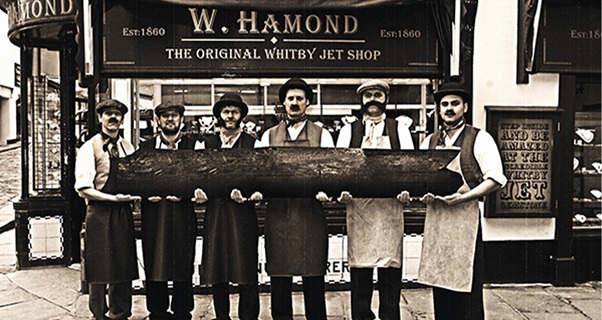 Jet and its use in both jewellery and decorative objects has a very long history, dating back to the end of the Paleolithic period. The earliest known use of this gemstone was found in Baden-Wurttemberg, Germany. Where a craved botfly larva was found and was dated to 10,000 BC. In Britian, Jet has been found in burial sites dating back to the Neolithlic period ( about 4,000 BC ). It was thought that during this period in Britain, Jet was collected along the North Yorkshire coast near Whitby rather than being mined. During the Roman occupation of Britain (3rd to 4th Century AD), Jet became highly sought after from the belief in its protective properties. Pling the Elder wrote that the stone could be used to protect the wearer from witchcraft. He also stated that the stone could be finely ground, then burned and that there was medicinal benefits to inhaling the smoke. Jet was very popular in Roman society and it was traded across the empire.
Jet and its use in both jewellery and decorative objects has a very long history, dating back to the end of the Paleolithic period. The earliest known use of this gemstone was found in Baden-Wurttemberg, Germany. Where a craved botfly larva was found and was dated to 10,000 BC. In Britian, Jet has been found in burial sites dating back to the Neolithlic period ( about 4,000 BC ). It was thought that during this period in Britain, Jet was collected along the North Yorkshire coast near Whitby rather than being mined. During the Roman occupation of Britain (3rd to 4th Century AD), Jet became highly sought after from the belief in its protective properties. Pling the Elder wrote that the stone could be used to protect the wearer from witchcraft. He also stated that the stone could be finely ground, then burned and that there was medicinal benefits to inhaling the smoke. Jet was very popular in Roman society and it was traded across the empire.
During the middle-ages Jet saw a decline in its popularity. It moved away from personal jewellery and became more widely used for decorative items such as chess pieces. It was also commonly used at this time for religious items such as rosary beads and crosses.
The early 19th Century saw a resurgence in Jet`s popularity, as it became central to Victorian Jewellery. This time as a mourning gemstone which reached its pinnacle in the latter part of the Victorian era. The first Whitby Jet workshop was opened around 1808 by a retired Navel Officer and was located in Haggersgate, Whitby. The industry as a whole grew steadily and gained international recognition in 1851 when it was displayed at the Great Exhibition in London. In 1861, Prince Albert died sending Queen Victoria into a state of mourning in which she remained for the rest of her life, a period of 40 years. During this time, she wore only black clothes and mourning jewellery with Jet jewellery being her main choice. She also set strict court etiquette that required black clothes and black jewellery. This of course lead to huge demand for Whitby Jet jewellery. Between the 1840s and the 1920s large-scale mining took place in North Yorkshire. At its peak around the 1870s, it is estimated that about 1,500 people were employed in the industry, mining and carving.
Folklore
As far back as the early Bronze age, Jet was believed to hold protective powers. This belief may have arisen from the fact that this gemstone can produce a static charge when rubbed. This belief in its protective powers included protection in the afterlife, with Jet Jewellery and objects being found in burial sites across Britain.
Greek Mythology: The ancient Greeks called the stone “Lithos Gagates” meaning “Stone of Gages”. They believed the stone had protective powers and medicinal properties. The Greek physician Galen reportedly used the gemstone to reduce swelling of the knees. In Greek mythology, the stone was associated with Hades, god of the underworld and king of the dead.
Roman Mythology: The Romans believed the stone could protect them, especially from the “evil eye” and/or spiritual attacks. For this reason, it was widely used in amulets and pendants. Roman magi (magicians) would use the stone to predict the future. By burning it on a red-hot axe and interpreting the pattern which would be formed as it burned. Pliny the Elder wrote that the smoke produced from burning this gemstone could drive away snakes and also had medicinal benefits if inhaled.
Medieval Europe: During the middle-ages in Europe the widespread belief in Jet`s protective and healing powers continued. Jet crosses would be placed on doors to ward off witches and evil. Sailors and fishermen`s wives would burn the gemstone in their fireplaces in the belief that it would protect their husbands at sea. It was also used for its medicinal benefits, when ground into a fine powder it was used to brush teeth, as a remedy for gout, and to ease pain in childbirth.
In the Catholic Church, it was a popular choice for rosary beads, crosses and religious pendants. Spanish craftsmen would often use the stone to carve statues of the Virgin Mary and the Christ Child, along with statues of other Saints.
Famous Jet

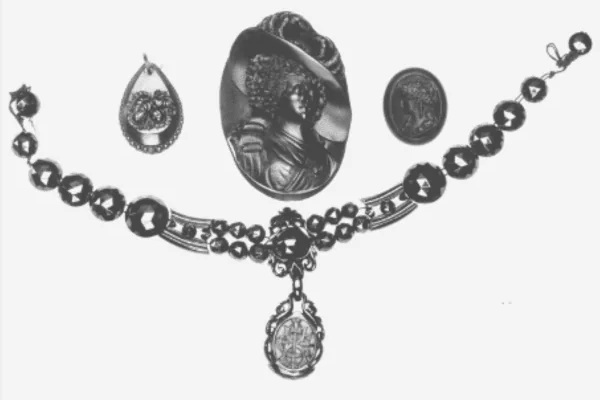
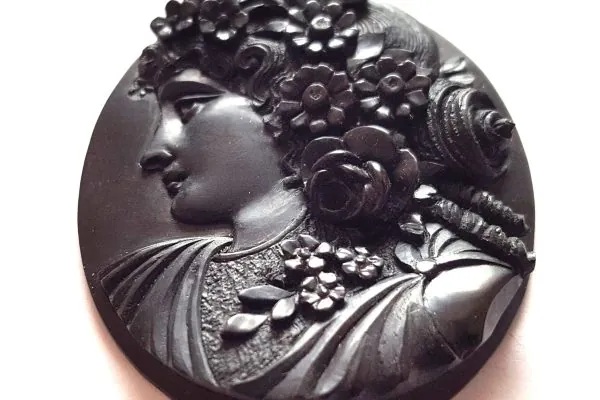
The above pieces of Jet are on display at the Whitby Museum.
Jet Gemological Data
Colour: Deep black, dark brown.
Colour of Streak: Black-brown.
Moh`s hardness: 2.5 – 4
Density: 1.19 – 1.35
Cleavage: None.
Fracture: Conchoidal.
Crystal system: Non-crystalline.
Transparency: Opaque.
Chemical composition: Lignite.
Refractive index: 1.640 – 1.680
Double refraction: None.
Pleochroism: Absent.
Dispersion: None.
Fluorescence: None.
For Researchers and Journalists
Recommended Citation (MLA) Format:
Hoyne, John. “Jet: Formation, History, Meaning, and Folklore.” Carus Jewellery, n.d., https://carusjewellery.com/jet/.
You can also get in touch with Carusjewellery.com on Facebook , where you may leave any comments or questions you may have about this article.

